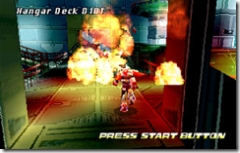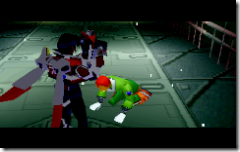Sonic Team’s 1998 3D firefighting game Burning Rangers often plays second-fiddle to their masterpiece NiGHTS into Dreams in terms of press coverage of the Saturn’s contribution to the world of gaming. However, it is still a game of considerable quality and innovation.
One of the great things about the Sonic Team games of the period was that their originality came right from the core; each game had a central premise which sought to do something different. I’m not going to go into whether Sonic Team still have these original concepts in them, but there can be no doubt they did in the Saturn’s time.
Strong Foundations
How refreshing – a game where you save people instead of killing them! This concept remains fresh to this day – the closest we really get now is stealth games where stunning/avoiding people is encouraged, but to have a game where the emphasis is on helping people is quite different.
For a game to have such a completely different ethos and attitude towards (admittedly virtual) life is highly refreshing – you are rewarded for saving a certain number of people in a level by increased scores, but the real rewards are emotional; characters you save send you email afterwards (via the in-game system; not real email, unfortunately) to express their thanks and update you with news on their lives. This sort of in-game communication brings an extra dimension to the game and allows character development without cutscenes or dialogue. In a way it’s more realistic this way, because they are directly addressing you, the player, not your character. Sonic Team sort of adapted the format for their Chao Daycare system in Sonic Adventure, whereby your Chao would send you real emails to tell you how they’re getting on. More games need this feature.
Depth Perceptions
There’s somewhere in the region of 100 characters to rescue, but only four levels.
“How is that possible?”
Well, it’s very simple – the levels change every time you play. Whereas NiGHTS had the amazing music-remix feature, Burning Rangers actually remixes the level designs every time, placing new corridors, rooms and survivors for each new play. It really is a very advanced system. If you complete a level and missed a number of survivors, or one of the “special” characters – Yuji Naka, Naoto Ohshima and artist Ami Shibata are all in there – you can write down the code displayed at the end and play again. Saving characters multiple times results in more email and, sometimes, more goodies – some characters give you extra options like the sound test, Ami Shibata gives you art and others give you codes to play as extra characters. Burning Rangers has replay value in spades. Sonic Team later reused this system for Phantasy Star Online Episode I and II.
No Sound of Music
There is no music in the levels, only sound effects and voices. This is because the game uses a voice navigation system to guide the player around levels, as well as update them about what other members of the team are doing. The other characters converse with each other over this system too, which often reveals a little about their relationships without interrupting the gameflow. Why should gameplay have to stop for character development?
The bosses are enormous. One of them is like a cross between Gulpo from NiGHTS and Chaos 4 from Sonic Adventure. The last one is very much like Phantasy Star Online’s Dark Falz. It’s interesting to see how these ideas started out on the Saturn before Sonic Team were able to refine them in their Dreamcast games.
It’s clear to me that Burning Rangers actually occupies a very important place in Sonic Team’s history. I always thought it didn’t quite fit in with the rest of their products, probably partly because it came out too close to the Saturn’s death to make any difference, and also it shows signs of having been rushed – another few months would have tightened it up still further, and a Dreamcast sequel would have been absolutely perfect.
Cooperative gaming and communication is becoming more popular and plausible all the time – wouldn’t it be great to see a Burning Rangers 2 on Xbox 360, with players able to communicate as part of a team to rescue survivors, negotiate tricky corridors and escape unharmed? Leave your thoughts in a comment!
A Word from James:
The site’s different look is totally accidental – I ran a WordPress upgrade and deleted my old pages, so I’m afraid the Virtual Tour is lost in the sands of time! I hope to find a way to resurrect it soon, and the same goes for the Game Diaries. Sorry for this temporary loss of content!
 My name is James Newton, and this is my website - a collection of my writings about
videogames, music and all my other thoughts.
My name is James Newton, and this is my website - a collection of my writings about
videogames, music and all my other thoughts.